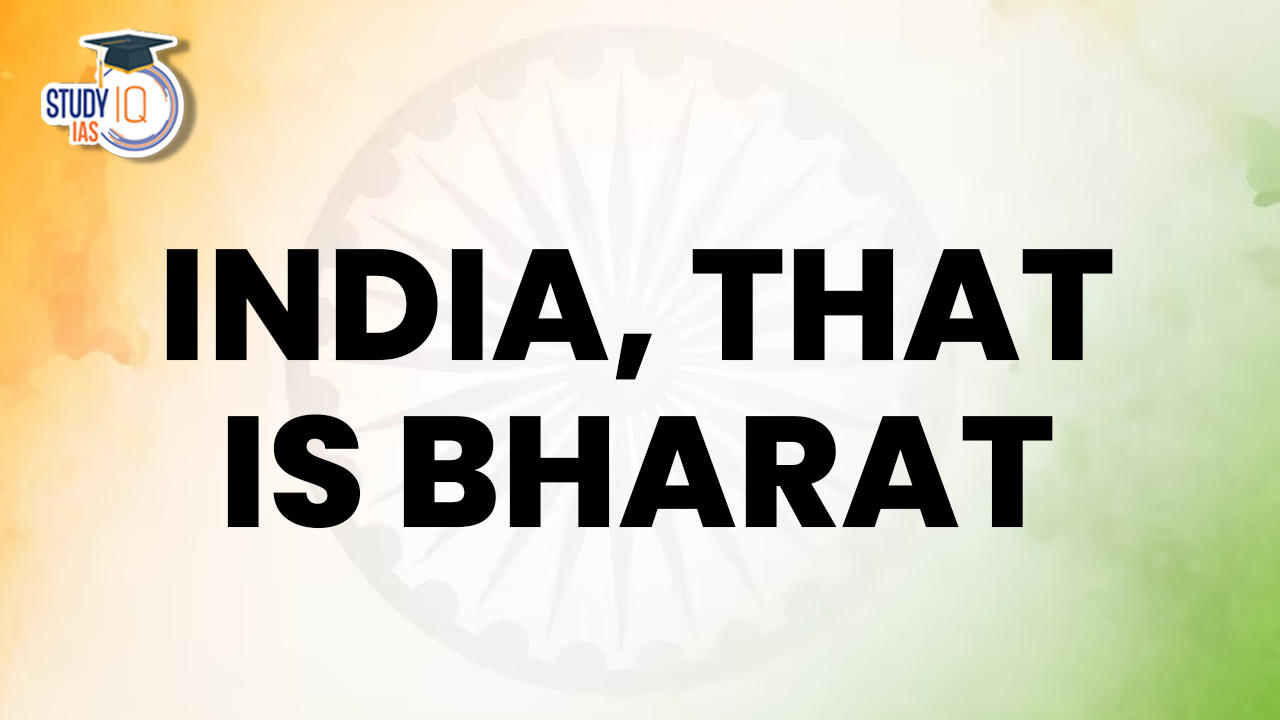Table of Contents
There are rumours of an official change in the name of the country from India to Bharat, even though Article 1 of the Constitution uses the two names interchangeably: “India, that is Bharat, shall be a Union of States.” Is it India or Bharat? The framers of the Indian Constitution debated on it while framing the Constitution. Therefore, Article 1 of the Constitution says, “India, that is Bharat, is a Union of States”. Both the names, India and Bharat, were made official and legal to be used for juridical-political purposes.
India Bharat Debate in Constitutional Assembly was one of the heated debates in the Constituent Assembly. On September 17, 1949, the “Name and territory of the Union” was brought up for discussion during the Constituent Assembly deliberations. A rift developed among the members as soon as the first item was read, which said that “India, that is Bharat, shall be a Union of States”. Many members opposed the usage of the name “India,” which they believed to be a reminder of the country’s colonial past. When the revisions were finally put to a vote by President Rajendra Prasad, Article 1 remained “India, that is Bharat.”
President of Bharat on G20 Dinner Invite
The Congress said that the Rashtrapati Bhawan had engraved ‘President of Bharat’ instead of the usual ‘President of India‘ on invitations to the G20 Summit. This sparked speculation that the administration would introduce a resolution to rename India Bharat during the next extraordinary session of Parliament.

“President of Bharat” rather than “President of India” appears on President Droupadi Murmu’s invitation to G20 foreign leaders and Chief Ministers for a dinner on September 9. According to officials, this is the first time India’s nomenclature for a formal function has changed. For the first time, the “President of Bharat” rather than the customary “President of India” is issuing official invitations to heads of state for a banquet on September 9 in Delhi.
India that is Bharat
Is it India or Bharat? The framers of our Constitution debated that and more. Therefore, Article 1 of the Constitution says, “India, that is Bharat, is a Union of States”. Both the names, India and Bharat, were made official and legal to be used for juridical-political purposes. In English, we call our nation India, while in other Indian languages, we call it Bharat. It is Bharata in Tamil, Bharatam in Malayalam, and Bharat desam in Telugu even in Dravidian languages. The Constitution is known as “Bharat ka Samvidhan” in Hindi. And Article 1 is, ‘Bharata arthat India, rajyon ka sangha hoga’.
Despite the fact that “India” refers to a physical and administrative entity, scholars claim that the native word “Bharat” derives from the idea of a socially organized region that was bound together by sociocultural traditions. Later, Bharat combined the cultural and geographic aspects of India to symbolize both.
India to be called ‘Bharat’ soon?
The central government is likely to bring a resolution for changing India’s official name to ‘Bharat’ Also, several names such as Reserve Bank of India and the Indian Railways already have Hindi variants with “Bharatiya” in them. during the special session of Parliament, scheduled from September 18-22.
However in June 2020 in order to “ensure the citizens of this country get over the colonial past,” the Supreme Court dismissed a PIL that sought to remove the term “India” from the Constitution and keep just the term “Bharat,” stating that “India is already called Bharat in the Constitution itself.”
What does the Constitution of India say?
The Constitution of India under Article 1 states that,
- India, that is Bharat shall be a Union of States
- The States and Union Territories thereof shall be specified in the 1st Schedule
- The territory of India shall comprise of
- Territory of States
- Union Territories specified in the First Schedule
- Other territories may be acquired.
Article 1 of the Constitution of India is an essential statement specifying what our country be called and what will comprise the sovereign territory of our nation. It acknowledges that India is a ‘Union of States’ and not a Federation of States where states and central government will work together to ensure the common good of the nation.
India vs Bharat
In Hindu works like the Mahabharata and Manusmriti, the term “Bharat” has a long history. It pertains to the Emperor Bharata, to whom Jawaharlal Nehru was alluding, who is believed to have ruled over a vast domain comparable to contemporary India. Bharat is being favoured because supporters say it captures the region’s rich cultural and historical heritage.
Jawaharlal Nehru in his writing in January 1927 on the “fundamental unity of India” that has persisted from “the far past”: “a unity of shared faith and culture. India was Bharata, the Hindus’ sacred land, and it is significant that the major Hindu pilgrimage sites are located there in the country’s four corners: the extreme south, which overlooks Ceylon, the extreme west, which is bordered by the Arabian Sea, the extreme east, which faces the Bay of Bengal, and the northern Himalayas.
British maps started to use the name “India” more frequently starting in the late 18th century, and “Hindustan” started to lose its link with all of South Asia. The term “India” may have had appeal in part because of its Graeco-Roman connections, lengthy history of use in Europe, and use by bureaucratic and scientific organizations like the Survey of India, according to Barrow. The introduction of India “suggests how colonial nomenclature signalled changes in perspectives and helped usher in an understanding of the subcontinent as a single, bounded, and British political territory,” the article states.





















 WhatsApp
WhatsApp